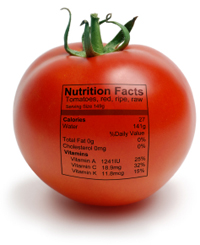 
OceanGrown's OceanSolution is the first line effort to ensure that food and feed crops are able to fulfill the highest quality nutrient uptake. But what does that really mean in terms of the end use of food and feed? The answer is complex and deserves a good bit attention and understanding. This site is the place to understand both the basics of nutrition and the role that OceanSolution has in helping the meet the nutrient needs for a healthy life.


I heard that the Food Guide Pyramid has been replaced. Is that true?
Yes, the new MyPyramid offers consumers a more personalized approach to healthy eating and physical activity.
What is a “healthy diet”?
A “healthy diet” is one that provides enough of each essential nutrient, contains a variety of foods from all of the basic food groups, provides adequate energy to maintain a healthy weight, and does not contain excess fat, sugar, salt or alcohol. The consumer pamphlet, Finding Your Way to a Healthier You: Based on the Dietary Guidelines for Americans provides guidelines that help promote health, and reduce the risk of chronic disease such as diabetes, cancer, and osteoporosis.
I would like to get advice about my eating habits.
Registered Dietitians (RD) are the health professionals who are trained to provide counseling on nutrition and eating habits. An RD can provide personalized dietary advice taking into consideration your health status, lifestyle, and food likes and dislikes.
How many servings do I need each day?
The number of servings you need each day from each food group depends on your calorie needs. To learn more, please visit MyPyramid to determine your calorie needs and servings.
|
|
 Nutrition
Nutrition (also called nourishment or aliment) is the provision, to cells and organisms, of the materials necessary (in the form of food) to support life. Many common health problems can be prevented or alleviated with a healthy diet.
Nutriton is a process of intake of nutrients (like carbohydrates, fats,proteins,Vitamins, minerals and water) by the organism as well as the utilisation of these nutrients by the organism.
The diet of an organism is what it eats, and is largely determined by the perceived palatability of foods.

|
What are RDAs and DRIs?
From 1941 to 1989, the Institute of Medicine's Food and Nutrition Board (FNB) released the Recommended Dietary Allowances or RDAs. The RDAs are a single set of nutrient specific values. During deliberations in the mid- 1990's the FNB decided to replace this single set of values with multiple sets of values, including: Estimated Average Requirements (EAR), Recommended Dietary Allowances (RDA), Adequate Intakes (AI), and Tolerable Upper Intake Levels, (UL) for designated age groups, physiologic states, and by sex. These values are collectively referred to as the Dietary Reference Intakes, or DRIs. To view the DRI tables please click the appropriate link below:
Elements (minerals - iron, calcium, zinc, iodine)
Vitamins
Macronutrients (protein, carbohydrates, fat, cholesterol, and energy)
Electrolytes and Water (includes minerals - sodium, potassium)
Visit the Food and Nutrition Information Center to see the full reports.
I've heard that people should cut back on how much trans fat they eat but I'm confused about what trans fats are and what foods have them.
Check out the following: Trans Fat Now Listed With Saturated Fat and Cholesterol on the Nutrition Facts Label.
I know there are different types of fiber in foods and that they have different effects on the body. Can you tell me about them? How much fiber should I eat?
Yes, the fiber in foods is generally broken down into 2 broad types - soluble (also called "viscous") and insoluble. Both types have important health effects. The recommended intake for total fiber for adults up to 50 years of age is set at 25 grams per day for women and 38 grams for men. For those over 50, the recommended intake is 21 grams for women and 30 grams for men.
To learn more about the types of fiber, their functions in the body, and food sources, check out:
Dietary Fiber from MedlinePlus
How is food digested?
Digestion begins in the mouth, when we chew and swallow, and is completed in the small intestine. Digestion involves the mixing of food, its movement through the digestive tract, and the breakdown of food into smaller molecules. The digestive process varies for different kinds of food. Your Digestive System and How It Works explains how food is digested and why digestion is important.
|
|

Nephrology is a branch of internal medicine and pediatrics dealing with the study of the function and diseases of the kidney.
Book: Critical Care Nephrology By Claudio Ronco, Rinaldo Bellomo, John Kellum
Overview: Because of the increase in serious kidney diseases, including end-stage renal disease, your role as a nephrologist, intensivist, surgeon, or critical care physician is quickly expanding. Well received in its 1st edition, this 2nd edition continues to provide comprehensive coverage of the latest advances in critical care procedures for the adult or pediatric patient with renal diseases or disorders. Presents a common language and standardized guidelines to help multi-disciplinary physicians caring for the critically ill communicate more effectively. A new US editor, detailed discussions of different forms of organ support, artificial organs, infections, acute illness occurring in chronic hemodialysis patients, and much more make this book an exceptional resource for anyone who treats critically ill renal patients. And, as an Expert Consult title, this meticulously updated 2nd edition comes with access to the complete contents online, fully searchable.
Sources: The information on this page was taken from: Wikipedia and Nutrition.gov.
|
|










